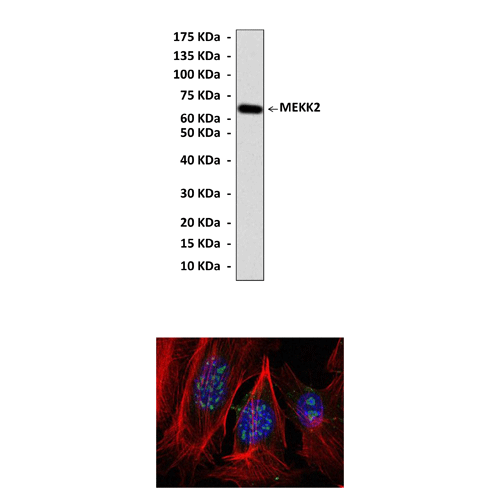Description
BACKGROUND MAPK cascades, which include ERK1/2, JNK, the big MAPK/ERK5, and the p38 MAPK cascades, are intracellular signaling networks utilized by mammalian cells to respond to a wide spectrum of extracellular stimuli. MAPKs are activated through a module that includes an MAPK, an MAPK kinase (MAPKK), and an MAPKK kinase (MAP3K). Located upstream in the MAPK module, an MAP3K phosphorylates and activates its downstream MAPKKs, which in turn phosphorylate and activate the downstream MAPKs. A growing number of MAP3Ks including MEKK1, MEKK2, MEKK3, MEKK4, apoptosis signal-regulating kinase 1 (ASK1), transforming growth factor-beta-activated kinase 1 (TAK1), dual leucine-zipper kinase, and tumor progression locus 2 (Tpl2) have been identified that are capable of activating multiple MAPKs. Because of its unique position in the MAPK module, a MAP3K is crucial in relaying the upstream receptor-mediated signals through the MAPK cascades to induce physiological responses. Biochemical and genetic studies have demonstrated that these MAP3Ks are crucial in relaying distinct cell-surface signals through various downstream MAPK pathways to their cytoplasmic and nuclear effectors. Studies using gene-targeting mice have also revealed that MAP3Ks have both overlapping and distinctive functions. For instance, many MAP3Ks also activate the IkappaB kinase (IKK)–nuclear factor B (NF-kappaB) pathway.1
MEKK2 and MEKK3 are two closely related MAP3Ks belonging to the MEKK/STE11 subfamily that are widely expressed and are potent activators of the NF- B and MAPK pathways. Extensive in vitro studies in the past have shown that they activate the JNK1/2, ERK1/2, p38, and ERK5 MAPKs. The in vivo function of MEKK2 and MEKK3 has also been studied in different physiologic systems, including MEKK2 and MEKK3 knockout mice and cells. These studies have shown that MEKK2 regulates T-cell function, controls cytokine gene expression in mast cells, mediates epidermal growth factor (EGF) receptor and fibroblast growth factor-2 (FGF-2) receptor signals, and plays a role in rheumatoid arthritis. In contrast, MEKK3 is essential for early mouse embryonic development, tumor necrosis factor alpha (TNFalpha)-induced IKK–NF-kappaB and JNK–p38 activation, and IL-1R–TLR4-induced IL-6 production via the IKK–NF- B and JNK–p38 MAPK pathways.2
MAP3Ks are often regulated by MAP4Ks as well as by association with scaffolds or adapters. It was shown that WNK1 binds to, phosphorylates, and activates MEKK3.3 Moreover, It was found that MEKK2 activation requires dimerizationcand MEKK2 dimerization motif is in its catalytic domain.4 In addition, the Ser 519 and Ser 526 in the activation loop of MEKK2 and MEKK3, respectively, are the key regulatory residues whose phosphorylation is essential for MEKK2 and MEKK3 activation.5
MEKK2 and MEKK3 are two closely related MAP3Ks belonging to the MEKK/STE11 subfamily that are widely expressed and are potent activators of the NF- B and MAPK pathways. Extensive in vitro studies in the past have shown that they activate the JNK1/2, ERK1/2, p38, and ERK5 MAPKs. The in vivo function of MEKK2 and MEKK3 has also been studied in different physiologic systems, including MEKK2 and MEKK3 knockout mice and cells. These studies have shown that MEKK2 regulates T-cell function, controls cytokine gene expression in mast cells, mediates epidermal growth factor (EGF) receptor and fibroblast growth factor-2 (FGF-2) receptor signals, and plays a role in rheumatoid arthritis. In contrast, MEKK3 is essential for early mouse embryonic development, tumor necrosis factor alpha (TNFalpha)-induced IKK–NF-kappaB and JNK–p38 activation, and IL-1R–TLR4-induced IL-6 production via the IKK–NF- B and JNK–p38 MAPK pathways.2
MAP3Ks are often regulated by MAP4Ks as well as by association with scaffolds or adapters. It was shown that WNK1 binds to, phosphorylates, and activates MEKK3.3 Moreover, It was found that MEKK2 activation requires dimerizationcand MEKK2 dimerization motif is in its catalytic domain.4 In addition, the Ser 519 and Ser 526 in the activation loop of MEKK2 and MEKK3, respectively, are the key regulatory residues whose phosphorylation is essential for MEKK2 and MEKK3 activation.5
REFERENCES
1. Seger,R. & Krebs,E.G. : FASEB J. 9:726-35, 1995
2. Uhlik, M.T. et al: Biochem. Cell Biol. 82:658-63, 2004
3. Xu, B. et al: Cell res. 15:6-10, 2005
4. Cheng, J. et al: J. Biol. Chem.280:13477-82, 2005
5. Zhang, D. et al: EMBO J. 25:907-17, 2006
2. Uhlik, M.T. et al: Biochem. Cell Biol. 82:658-63, 2004
3. Xu, B. et al: Cell res. 15:6-10, 2005
4. Cheng, J. et al: J. Biol. Chem.280:13477-82, 2005
5. Zhang, D. et al: EMBO J. 25:907-17, 2006
Products are for research use only. They are not intended for human, animal, or diagnostic applications.
Details
|
Cat.No.:
|
CP10425
|
|
Antigen:
|
Raised against recombinant human MEKK2 fragments expressed in E. coli.
|
|
Isotype:
|
Mouse IgG1
|
|
Species & predicted
species cross-
reactivity ( ):
|
Human, Mouse, Rat
|
|
Applications &
Suggested starting
dilutions:*
|
WB 1:1000
IP n/d
IHC n/d
ICC 1:50 - 1:200
FACS n/d
|
|
Predicted Molecular
Weight of protein:
|
70 kDa
|
|
Specificity/Sensitivity:
|
Detects MEKK2 proteins in various cell lysate.
|
|
Storage:
|
Store at -20°C, 4°C for frequent use. Avoid repeated freeze-thaw cycles.
|
*Optimal working dilutions must be determined by end user.
Products
| Product | Size | CAT.# | Price | Quantity |
|---|---|---|---|---|
| Mouse Plakoglobin/JUP Antibody: Mouse Plakoglobin/JUP Antibody | Size: 100 ul | CAT.#: CP10424 | Price: $457.00 |

